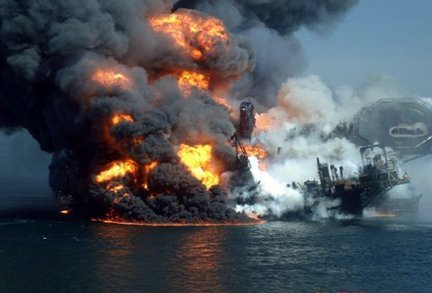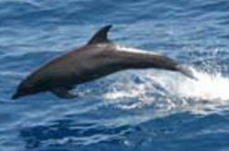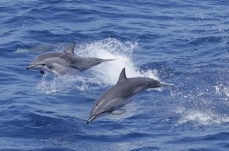Environmental impacts of oil spills (main)
Environmental impacts of oil spills
The impact of an oil spill on marine life is related to the size of the spill, the type of oil, and sensitivity of the ecosystem. Oil spills kill fish, mammals, birds, and their offspring; destroy plant life; and reduce the food supply for organisms that survive. Spills also disrupt the structure and function of marine communities and ecosystems. The riskiest toxins are a class of organic compounds known as polycyclic aromatic hydrocarbons, or PAHs. Growing evidence suggests that PAHs and other toxic compounds can have adverse effects on marine species even at very low concentrations. This means chronic releases from runoff and recreational boating may inflict more damage than previously thought, and that the effects of large spills may last as long as residual oil persists in the area.
-
 Featured News Article
Featured News Article  Public Input: Deepwater Horizon Accident Early...Deepwater Horizon Natural Resource Damage Assessment Call for Public Input on Early Restoration of the Gulf Sixty-day public comment period for Draft Phase I Early... More »
Public Input: Deepwater Horizon Accident Early...Deepwater Horizon Natural Resource Damage Assessment Call for Public Input on Early Restoration of the Gulf Sixty-day public comment period for Draft Phase I Early... More »
-
 Featured News Article
Featured News Article  Deepwater Horizon effects on fishGulf of Mexico Deepwater Horizon Spill Effects on Fish Revealed Oil spill resulted in dramatic effects on fish species in Louisiana marshes Despite low concentrations of oil... More »
Deepwater Horizon effects on fishGulf of Mexico Deepwater Horizon Spill Effects on Fish Revealed Oil spill resulted in dramatic effects on fish species in Louisiana marshes Despite low concentrations of oil... More »
-
 Featured Video Oil spill impacts on coastal wetlands of the...Date of Video: Jun. 3, 2010 LSU professors and wetland ecologists, Dr. Irving Mendelssohn and Dr. Karen McKee, answer questions about possible oil spill effects on wetlands,... More »
Featured Video Oil spill impacts on coastal wetlands of the...Date of Video: Jun. 3, 2010 LSU professors and wetland ecologists, Dr. Irving Mendelssohn and Dr. Karen McKee, answer questions about possible oil spill effects on wetlands,... More »
-
 Featured Video Sperm whales, shrimp and uncertainty: BP's...Date of Video: May 31, 2010 2nd episode in an ongoing series documenting BP's drilling disaster, and its impacts on the Gulf ecosystem and coastal communities. Featuring images... More »
Featured Video Sperm whales, shrimp and uncertainty: BP's...Date of Video: May 31, 2010 2nd episode in an ongoing series documenting BP's drilling disaster, and its impacts on the Gulf ecosystem and coastal communities. Featuring images... More »
-
 Featured Video Did Gulf spill boost "Dead Zone"? (3:34)Date of Video: Oct. 25, 2010 Microbes consuming oil from the Gulf of Mexico's BP spill deplete oxygen levels when they die, raising the threat of an expanded "dead... More »
Featured Video Did Gulf spill boost "Dead Zone"? (3:34)Date of Video: Oct. 25, 2010 Microbes consuming oil from the Gulf of Mexico's BP spill deplete oxygen levels when they die, raising the threat of an expanded "dead... More »
-
 Featured Video The oil spill's toxic trade-off (17:14)Date of Video: Jun. 28, 2010 Break down the oil slick, keep it off the shores: that's grounds for pumping toxic dispersant into the Gulf, say clean-up overseers. Susan Shaw shows... More »
Featured Video The oil spill's toxic trade-off (17:14)Date of Video: Jun. 28, 2010 Break down the oil slick, keep it off the shores: that's grounds for pumping toxic dispersant into the Gulf, say clean-up overseers. Susan Shaw shows... More »
-
 Featured Article
Featured Article  Deepwater Horizon Oil Spill and Marine MammalsThe Deepwater Horizon Oil Spill and Marine Mammals Marine Mammals at Risk in the Gulf of Mexico Stock assessment reports compiled by the National Marine Fisheries Service... More »
Deepwater Horizon Oil Spill and Marine MammalsThe Deepwater Horizon Oil Spill and Marine Mammals Marine Mammals at Risk in the Gulf of Mexico Stock assessment reports compiled by the National Marine Fisheries Service... More »
-
 Featured Article
Featured Article  Oil spills in mangrovesEditor's Note: This article is excerpted directly from NOAA, "Oil Spills in Mangroves: Planning and Response Considerations, " July 2010. It has been edited only to... More »
Oil spills in mangrovesEditor's Note: This article is excerpted directly from NOAA, "Oil Spills in Mangroves: Planning and Response Considerations, " July 2010. It has been edited only to... More »
-
 Featured Article
Featured Article  Marine life and fisheries in the Gulf of MexicoOne of the biggest industries in the Gulf of Mexico is the fishing (commercial and recreational). In 2008, commercial fishermen in the Gulf of Mexico harvested 1.27 billion... More »
Marine life and fisheries in the Gulf of MexicoOne of the biggest industries in the Gulf of Mexico is the fishing (commercial and recreational). In 2008, commercial fishermen in the Gulf of Mexico harvested 1.27 billion... More »
 Arctic offshore oil exploration spill response planning Last Updated on 2012-05-11 00:00:00 Worldwide, oil and gas companies are being forced by resource declines to drill in less accessible areas, and the Arctic is their newest frontier. This article, written by Charles W. Schmidt*, appeared first in Environmental Health Perspectives—the peer-reviewed, open access journal of the National Institute of Environmental Health Sciences. The article is a verbatim version of the original and is not available for edits or additions by Encyclopedia of Earth editors or authors. Companion articles on the same topic that are editable may exist within the Encyclopedia of Earth. Offshore Exploration in the Arctic: Can Shell’s Oil-Spill Response Plans Keep Up? All around the world, oil and gas companies are being forced by resource declines to drill in less accessible areas, and the Arctic is their newest frontier. The geology above the Arctic... More »
Arctic offshore oil exploration spill response planning Last Updated on 2012-05-11 00:00:00 Worldwide, oil and gas companies are being forced by resource declines to drill in less accessible areas, and the Arctic is their newest frontier. This article, written by Charles W. Schmidt*, appeared first in Environmental Health Perspectives—the peer-reviewed, open access journal of the National Institute of Environmental Health Sciences. The article is a verbatim version of the original and is not available for edits or additions by Encyclopedia of Earth editors or authors. Companion articles on the same topic that are editable may exist within the Encyclopedia of Earth. Offshore Exploration in the Arctic: Can Shell’s Oil-Spill Response Plans Keep Up? All around the world, oil and gas companies are being forced by resource declines to drill in less accessible areas, and the Arctic is their newest frontier. The geology above the Arctic... More »  Public Input: Deepwater Horizon Accident Early Restoration Plan Last Updated on 2012-01-15 00:00:00 Deepwater Horizon Natural Resource Damage Assessment Call for Public Input on Early Restoration of the Gulf Sixty-day public comment period for Draft Phase I Early Restoration Plan The Deepwater Horizon Natural Resource Damage Assessment (NRDA) Trustees (Trustees) has released the Deepwater Horizon Draft Phase I Early Restoration Plan and Environmental Assessment (DERP/EA) for formal public comment. It is the first in an anticipated series of plans to begin restoration of the Gulf of Mexico to compensate for natural resource injuries, including the loss of human use of Gulf resources, from the Deepwater Horizon Oil Spill. The DERP/EA describes the initial projects proposed to receive funding from the $1 billion Early Restoration agreement announced by the Trustees and BP on April 21, 2011, called the Framework Agreement. The Trustees will hold 12 public meetings in... More »
Public Input: Deepwater Horizon Accident Early Restoration Plan Last Updated on 2012-01-15 00:00:00 Deepwater Horizon Natural Resource Damage Assessment Call for Public Input on Early Restoration of the Gulf Sixty-day public comment period for Draft Phase I Early Restoration Plan The Deepwater Horizon Natural Resource Damage Assessment (NRDA) Trustees (Trustees) has released the Deepwater Horizon Draft Phase I Early Restoration Plan and Environmental Assessment (DERP/EA) for formal public comment. It is the first in an anticipated series of plans to begin restoration of the Gulf of Mexico to compensate for natural resource injuries, including the loss of human use of Gulf resources, from the Deepwater Horizon Oil Spill. The DERP/EA describes the initial projects proposed to receive funding from the $1 billion Early Restoration agreement announced by the Trustees and BP on April 21, 2011, called the Framework Agreement. The Trustees will hold 12 public meetings in... More »  Deepwater Horizon effects on fish Last Updated on 2011-09-27 00:00:00 Gulf of Mexico Deepwater Horizon Spill Effects on Fish Revealed Oil spill resulted in dramatic effects on fish species in Louisiana marshes Despite low concentrations of oil constituents in Gulf of Mexicowaters from the Deepwater Horizon spill, fish were dramatically affected by toxic components of the oil. So found a team led by scientists Fernando Galvez and Andrew Whitehead of Louisiana State University (LSU). The researchers published their results in the journal Proceedings of the National Academy of Sciences (PNAS) Open Access Article. Galvez, Whitehead and colleagues undertook a combined field and laboratory study. It showed widespread effects of the Deepwater Horizon oil spill on fish in Louisiana marshes. Gene expression in tissues of the fish studied--in this case killifish--was predictive of oil spill responses such as developmental abnormalities and... More »
Deepwater Horizon effects on fish Last Updated on 2011-09-27 00:00:00 Gulf of Mexico Deepwater Horizon Spill Effects on Fish Revealed Oil spill resulted in dramatic effects on fish species in Louisiana marshes Despite low concentrations of oil constituents in Gulf of Mexicowaters from the Deepwater Horizon spill, fish were dramatically affected by toxic components of the oil. So found a team led by scientists Fernando Galvez and Andrew Whitehead of Louisiana State University (LSU). The researchers published their results in the journal Proceedings of the National Academy of Sciences (PNAS) Open Access Article. Galvez, Whitehead and colleagues undertook a combined field and laboratory study. It showed widespread effects of the Deepwater Horizon oil spill on fish in Louisiana marshes. Gene expression in tissues of the fish studied--in this case killifish--was predictive of oil spill responses such as developmental abnormalities and... More »  Cleaning Oiled Feathers Last Updated on 2011-06-04 00:00:00 In this experiment developed by NOAA, students will look at the way oil affects bird feathers and try out different cleanup methods to find out which works best. Materials: Clean, dry feathers (good places to find feathers are beaches, parks, and pet stores) Three bowls Vegetable oil Dish-washing detergent Hot and cold water (the hot water should be about the same temperature you'd use to wash dishes, and not too hot to put your hands in) Cleaning Oiled Feathers Lab Activity Instructions More »
Cleaning Oiled Feathers Last Updated on 2011-06-04 00:00:00 In this experiment developed by NOAA, students will look at the way oil affects bird feathers and try out different cleanup methods to find out which works best. Materials: Clean, dry feathers (good places to find feathers are beaches, parks, and pet stores) Three bowls Vegetable oil Dish-washing detergent Hot and cold water (the hot water should be about the same temperature you'd use to wash dishes, and not too hot to put your hands in) Cleaning Oiled Feathers Lab Activity Instructions More »